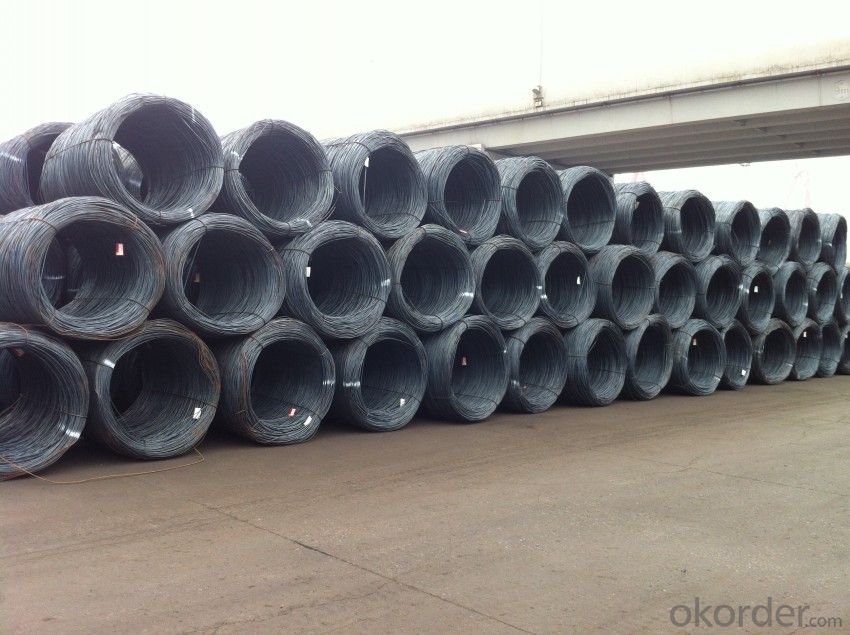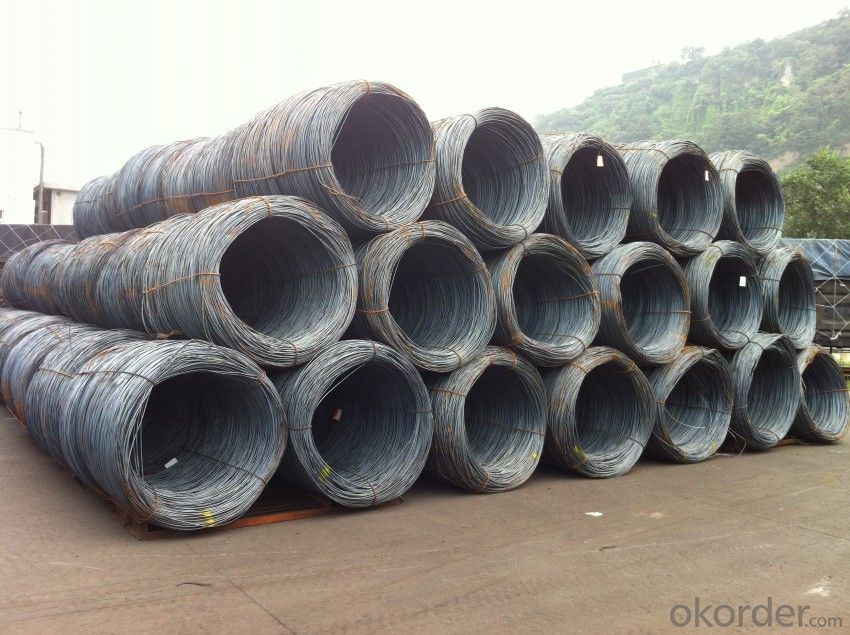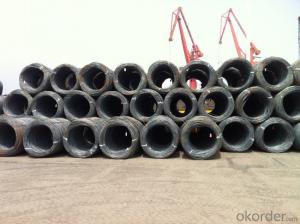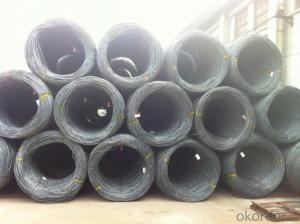Hot Rolled Wire Rods with Material Grade SAE 1008
- Loading Port:
- Tianjin
- Payment Terms:
- TT OR LC
- Min Order Qty:
- 25 m.t.
- Supply Capability:
- 10000 m.t./month
OKorder Service Pledge
OKorder Financial Service
You Might Also Like
Product Description:
OKorder is offering Carbon Steel Wire Rod at great prices with worldwide shipping. Our supplier is a world-class manufacturer of steel, with our products utilized the world over. OKorder annually supplies products to European, North American and Asian markets. We provide quotations within 24 hours of receiving an inquiry and guarantee competitive prices.
Product Applications:
Carbon Steel Wire Rod are ideal for structural applications and are widely used in the construction of buildings and bridges, and the manufacturing, petrochemical, and transportation industries.After hot-rolled the products shaped into coil and delivery as finished product, including round, square, rectangular, hexagonal and so on. Since most of the products are round, it is generally called wire rod. Carbon steel wire rod is widely used in construction and manufacturing. Carbon steel wire rod is mainly used for reinforcement of reinforced concrete and welded structure or reprocessed (roberts , nail, etc.) materials, especially used to produce wire drawing, welding electrode, nails, spring, electronic, precise machinery parts and so on.
Product Advantages:
OKorder's Carbon Steel Wire Rod are durable, strong, and resist corrosion.
Main Product Features:
· Premium quality
· Prompt delivery & seaworthy packing (30 days after receiving deposit)
· Corrosion resistance
· Can be recycled and reused
· Mill test certification
· Professional Service
· Competitive pricing
Product Specifications:
Chemical Composition:
Please kindly find our chemistry of our material based on SAE1006/SAE1008 as below for your information
Grade | Chemical Composition (%) | |||||
C | Mn | S | P | Si | B | |
SAE1006B | 0.03~O.07 | 0.32max | 0.045max | 0.040max | 0.30max | 0.0008min |
Mechanical properties | ||||||
Yield strength(N/mm2) | Tensile strength(N/mm2) | Elongation (%) | ||||
250-280 | 350-380 | ≥32 | ||||
Grade | Chemical Composition (%) | |||||
C | Mn | S | P | Si | B | |
SAE1008B | 0.10max | 0.3~0.50 | 0.050max | 0.040 max | 0.15max | 0.0008 min |
Mechanical properties | ||||||
Yield strength(N/mm2) | Tensile strength(N/mm2) | Elongation (%) | ||||
≥195 | 315-430 | ≥30 | ||||
FAQ:
Q1: Why buy Materials & Equipment from OKorder.com?
A1: All products offered byOKorder.com are carefully selected from China's most reliable manufacturing enterprises. Through its ISO certifications, OKorder.com adheres to the highest standards and a commitment to supply chain safety and customer satisfaction.
Q2: How do we guarantee the quality of our products?
A2: We have established an advanced quality management system which conducts strict quality tests at every step, from raw materials to the final product. At the same time, we provide extensive follow-up service assurances as required.
Q3: How soon can we receive the product after purchase?
A3: Within three days of placing an order, we will begin production. The specific shipping date is dependent upon international and government factors, but is typically 7 to 10 workdays.
Image


- Q:How is steel wire rod used in the production of wire strands for cable-stayed bridges?
- Steel wire rod is used in the production of wire strands for cable-stayed bridges as it serves as the primary material for manufacturing these strands. The wire rod is often hot-rolled, which improves its strength and durability, making it suitable for withstanding the tension and load-bearing requirements of cable-stayed bridges. The wire strands are formed by twisting multiple steel wires together, creating a strong and flexible structure that can support the weight of the bridge deck. These wire strands are then attached to the bridge pylon and anchorages, providing the necessary strength and stability to hold the bridge cables in place. Overall, steel wire rod plays a crucial role in the construction of wire strands, contributing to the structural integrity and safety of cable-stayed bridges.
- Q:What are the main factors affecting the market loyalty of steel wire rod?
- The main factors affecting the market loyalty of steel wire rod can include the quality and durability of the product, competitive pricing, reliable and timely delivery, customer service and support, availability of different grades and sizes, and the reputation and trustworthiness of the supplier. Additionally, factors such as market demand and trends, technological advancements, and environmental sustainability can also influence market loyalty.
- Q:How is steel wire rod used in the manufacturing of wire rope chains?
- Steel wire rod is the primary material used in the manufacturing of wire rope chains. It serves as the raw material that is drawn, twisted, and coated to create the individual strands of the wire rope chain. The wire rod's high tensile strength and durability make it suitable for withstanding heavy loads, making it an essential component in the production of wire rope chains.
- Q:How is steel wire rod inspected for quality control?
- Steel wire rod is inspected for quality control through various methods. Firstly, visual inspection is conducted to check for surface defects such as cracks, scratches, or deformities. This is followed by dimensional checks to ensure the wire rod meets the specified diameter and length requirements. Additionally, mechanical tests like tensile strength and elongation are performed to assess the wire rod's strength and flexibility. Chemical analysis is also conducted to determine the composition of the steel, ensuring it meets the required standards. All these inspections help ensure that the steel wire rod meets the desired quality standards before being used in various applications.
- Q:What are the different types of steel wire rod rolling processes?
- There are several different types of steel wire rod rolling processes, each with its own unique characteristics and advantages. Some of the most commonly used processes include: 1. Hot rolling: This is the most common method used to produce steel wire rods. In this process, the steel is heated above its recrystallization temperature and passed through a series of rolling mills to reduce its thickness and increase its length. Hot rolling results in a finer grain structure, improved mechanical properties, and a higher surface quality. 2. Cold rolling: This process involves passing the steel wire rod through a series of rolling mills at room temperature or below its recrystallization temperature. Cold rolling is typically used to produce smaller diameter wire rods with tighter tolerances and improved surface finish. It also provides higher strength and hardness compared to hot rolling. 3. Thermomechanical rolling: This process combines elements of both hot and cold rolling. The steel wire rod is heated to a temperature slightly above its recrystallization temperature and then rolled at a lower temperature. This allows for better control over the mechanical properties and microstructure of the wire rod, resulting in enhanced strength and toughness. 4. Controlled cooling rolling: In this process, the steel wire rod is cooled at a controlled rate after hot rolling. This controlled cooling helps to refine the microstructure and enhance the mechanical properties of the wire rod. It is commonly used to produce high-strength wire rods for applications requiring excellent fatigue resistance and durability. 5. Micro-alloyed rolling: This process involves adding small amounts of alloying elements, such as vanadium or niobium, to the steel wire rod before rolling. These alloying elements help to refine the grain structure and improve the mechanical properties of the wire rod, such as strength and toughness. Micro-alloyed rolling is often used to produce wire rods for high-stress applications, such as automotive and construction industries. Overall, the choice of steel wire rod rolling process depends on the desired properties and specifications of the end product. Each process offers distinct advantages and can be tailored to meet specific industry requirements.
- Q:What are the main factors influencing the choice of steel wire rod surface finish?
- The choice of steel wire rod surface finish is influenced by several factors, each of which plays a significant role in determining the appropriate finish for a particular application. One of the main factors is the intended use of the wire rod. Different surface finishes offer varying levels of corrosion resistance, lubricity, and adhesion properties, which are crucial considerations in determining the suitability of the wire rod for a specific application. For example, a wire rod used in a corrosive environment may require a surface finish that provides enhanced resistance to rust and oxidation. Another factor influencing the choice of surface finish is the desired aesthetic appearance. Certain industries, such as automotive or consumer goods, may have specific requirements for the visual appeal of the wire rod. In such cases, finishes that offer a smooth, polished, or decorative appearance may be preferred. The mechanical properties required for the wire rod's application also play a role in determining the surface finish. Some finishes, such as a bright or polished surface, can improve the wire rod's yield strength, ductility, and fatigue resistance. These properties are vital in applications that involve high-stress conditions or require flexibility and durability. Cost considerations also come into play when selecting the surface finish. Some finishes require additional processing steps, such as pickling, coating, or electroplating, which can increase the overall cost of the wire rod. Therefore, it is essential to balance the desired surface finish with the cost-effectiveness of the manufacturing process. Lastly, environmental and regulatory factors can influence the choice of surface finish. Certain finishes may contain hazardous substances or require specific disposal methods, which can impact the environmental footprint of the wire rod production. Compliance with industry standards and regulations is crucial to ensure the safety and sustainability of the finished product. In conclusion, the choice of steel wire rod surface finish is influenced by factors such as intended use, aesthetic requirements, mechanical properties, cost considerations, and environmental considerations. By carefully considering these factors, manufacturers can select the most appropriate surface finish that aligns with the specific requirements of the application and ensures the optimal performance and quality of the wire rod.
- Q:How is steel wire rod stored to prevent corrosion?
- To minimize the risk of corrosion, steel wire rods are typically stored in specific ways. One method involves placing the rods in a well-ventilated area with controlled humidity levels, preventing moisture accumulation and accelerating the corrosion process. Another preventive measure is to store the rods in a dry environment, elevated off the ground. This can be achieved by using pallets or racks to keep the rods from direct contact with the floor, avoiding any potential moisture or water accumulation on the ground. Furthermore, steel wire rods can be stored indoors in a warehouse with climate control. By maintaining a stable temperature and humidity level, the chances of corrosion are significantly reduced. These controlled environments effectively minimize moisture exposure and prevent rust formation on the wire rods. Additionally, a common preventive measure involves applying a protective coating to the steel wire rods. Coatings such as zinc or epoxy act as barriers between the rods and the surrounding environment, effectively preventing moisture from reaching the surface and causing corrosion. Overall, proper storage of steel wire rods entails minimizing moisture exposure, maintaining controlled humidity levels, elevating the rods off the ground, and using protective coatings. These measures greatly reduce the risk of corrosion, ensuring that the wire rods remain in optimal condition until they are ready for use.
- Q:How is steel wire rod used in the manufacturing of automotive springs?
- Steel wire rod is commonly used in the manufacturing of automotive springs due to its high tensile strength and durability. It is first drawn into the desired thickness and then coiled to form the spring shape. The wire rod's strength allows the spring to withstand heavy loads and provide the necessary support and stability for the vehicle's suspension system. Additionally, its ability to resist deformation and maintain its shape over time ensures the longevity and reliability of the automotive springs.
- Q:What are the main factors influencing the choice of steel wire rod order warranty claims process?
- The main factors influencing the choice of steel wire rod order warranty claims process include the quality of the wire rod, the reputation and track record of the supplier, the terms and conditions of the warranty, the cost and convenience of the claims process, and the level of customer support provided by the supplier.
- Q:How are steel wire rods used in the manufacturing of piano strings for musical instruments?
- Steel wire rods are an essential component in the manufacturing of piano strings for musical instruments. These wire rods are typically made of high-quality steel that is carefully engineered to provide the desired properties for piano strings. The first step in utilizing steel wire rods is to draw them through a series of dies to reduce their diameter and increase their tensile strength. This process, known as wire drawing, ensures that the steel wire rods are strong enough to withstand the tension required for piano strings. Once the steel wire rods have been drawn to the desired size, they are further processed to form the individual piano strings. The wire is cut into specific lengths and then coiled to create the desired shape and size for each string. These coils are then wound around a core wire, which provides stability and enhances the tonal quality of the string. The use of steel wire rods in piano string manufacturing is crucial for several reasons. Firstly, steel is known for its durability and resistance to stretching, making it ideal for withstanding the constant tension and pressure exerted on piano strings. Additionally, steel wire rods have excellent flexibility, allowing the strings to vibrate freely and produce a rich, resonant sound. Moreover, the precise manufacturing process of steel wire rods ensures that the resulting piano strings have consistent quality and uniformity. This is crucial for maintaining the integrity and balance of sound across the entire piano keyboard. In conclusion, steel wire rods play a vital role in the manufacturing of piano strings. Their strength, flexibility, and precision make them an ideal material for producing high-quality strings that can withstand the demanding requirements of a piano.
1. Manufacturer Overview |
|
|---|---|
| Location | |
| Year Established | |
| Annual Output Value | |
| Main Markets | |
| Company Certifications | |
2. Manufacturer Certificates |
|
|---|---|
| a) Certification Name | |
| Range | |
| Reference | |
| Validity Period | |
3. Manufacturer Capability |
|
|---|---|
| a)Trade Capacity | |
| Nearest Port | |
| Export Percentage | |
| No.of Employees in Trade Department | |
| Language Spoken: | |
| b)Factory Information | |
| Factory Size: | |
| No. of Production Lines | |
| Contract Manufacturing | |
| Product Price Range | |
Send your message to us
Hot Rolled Wire Rods with Material Grade SAE 1008
- Loading Port:
- Tianjin
- Payment Terms:
- TT OR LC
- Min Order Qty:
- 25 m.t.
- Supply Capability:
- 10000 m.t./month
OKorder Service Pledge
OKorder Financial Service
Similar products
New products
Hot products
Related keywords




























